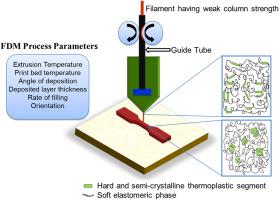Additive Manufacturing ( IF 10.3 ) Pub Date : 2021-07-13 , DOI: 10.1016/j.addma.2021.102177 Pratiksha Awasthi 1 , Shib Shankar Banerjee 1

|
Thermoplastic elastomer (TPE), one of the most important classes of specialty polymeric materials, has immense potential in several industrial applications. They have unique rubber like elasticity, thermoplastics like processability and recyclability. Compared to the conventional processing methods, material extrusion 3D printing based on fused deposition modeling (FDM) is an advanced and highly sophisticated processing technology which allows rapid prototyping and mass customization and is an ideal processing method for thermoplastic elastomeric materials to fabricate several complex computerized geometrics. However, FDM 3D printing of thermoplastic elastomeric materials is currently in the development stage and is facing several challenges including limited FDM compatible printable TPEs, difficulties in printability of soft TPEs, several defects in printed parts and poor mechanical properties. The objective of this review article is to figure out the ideas to address these challenges. It focuses on how to develop FDM compatible new thermoplastic elastomeric materials and how to make unprintable commercially available TPEs printable. The state-of-the-art advancements in FDM 3D printing of thermoplastic elastomeric materials are summarized. Strategies to overcome the defects in 3D printed TPE parts and to improve mechanical and thermoplastic elastomeric properties of 3D printed TPEs are provided. Finally, further prospective for this rapidly progressing field are critically discussed to motivate potential research in this field. It is expected that this review will be useful for both the academia and industries for any research work involved with the FDM of thermoplastic elastomeric materials.
中文翻译:

热塑性弹性体材料的熔融沉积建模:挑战和机遇
热塑性弹性体 (TPE) 是最重要的一类特种聚合物材料,在多种工业应用中具有巨大的潜力。它们具有独特的橡胶般的弹性、热塑性塑料般的可加工性和可回收性。与传统的加工方法相比,基于熔融沉积建模(FDM)的材料挤出3D打印是一种先进且高度复杂的加工技术,可实现快速成型和大规模定制,是热塑性弹性体材料制造多种复杂计算机几何图形的理想加工方法。 . 然而,热塑性弹性体材料的 FDM 3D 打印目前处于开发阶段,面临着一些挑战,包括有限的 FDM 兼容可打印 TPE、软 TPE 的可打印性困难、印刷部件存在多种缺陷,机械性能较差。这篇评论文章的目的是找出解决这些挑战的想法。它侧重于如何开发与 FDM 兼容的新型热塑性弹性体材料,以及如何使不可印刷的市售 TPE 可印刷。总结了热塑性弹性体材料 FDM 3D 打印的最新进展。提供了克服 3D 打印 TPE 部件中的缺陷并改善 3D 打印 TPE 的机械和热塑性弹性体性能的策略。最后,批判性地讨论了这个快速发展领域的进一步前景,以激发该领域的潜在研究。











































 京公网安备 11010802027423号
京公网安备 11010802027423号